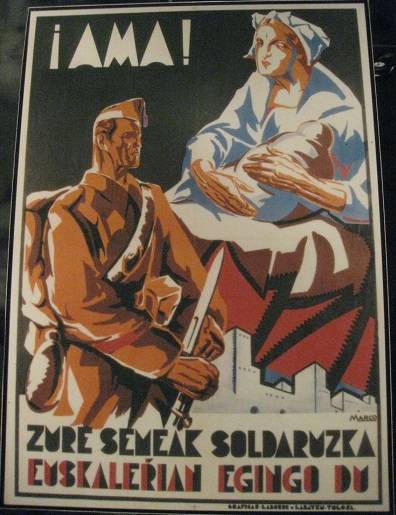Club Motorhome Bloggers
Spain, A Brief Encounter with the Spanish Civil War- Part 1
I first visited Spain as an eight year old in 1961 when Franco still had an iron grip on the country. This was 16 years after the Second World War which was preceded by three years of Civil War. Away from the metropolis the country was poor, old women dressed in black still carried bundles of washing on their heads to the communal wash house. Bare foot street urchins banged on the car window begging for Pesetas while their full breasted mothers in red dresses danced the flamenco and their menfolk strummed the Guitarra and smoked cigarillos. The place was dark, very dark, it was if the Moors had only left the country yesterday. Ok, I might have overdone that a bit but I just wanted to paint a picture of how much has changed in fifty years or so. However, scratch the surface of this country and the pain, suffering and scars are just under the skin and in some cases still visible today.

Spanish Civil war propaganda posters
8th April 2016 - Guernica Basque Country
Our first stop on this homage to the civil war was Guernica, situated in the valley of the Oka River in the Basque region of Northern Spain. On April 26, 1937 the town was razed to the ground by German aircraft. The purpose of the attack was to support Franco’s troops and as an experiment for the blitzkrieg tactics and bombing of civilians seen in later wars. Official Basque figures suggest 1,654 civilians were killed. To commemorate the event the town has a ‘Peace Museum’ depicting life at the time with historical accounts of the fateful day. In the museum there is a mock-up of a typical Spanish home. On entering, the doors close and that fateful day of the 26th April is relived. In addition to the museum, this pleasant town has some fine buildings and is well worth a visit. There is a large, albeit busy, car park that is suitable for motorhomes situated adjacent to the railway station. We did not stay here but choose the small fishing town, Bermeo, sixteen kilometres north. Details of the Aire can be found in the Club Motorhome Stopovers
The Peace Museum Guernica
10th April 2016 – Burgos Castile y León
For Burgos, the historic capital of Castile y Leon, involvement in the Civil War was far less traumatic. However, this was a base of General Franco's rebel Nationalist government and many a cruel plan was drawn here for the kidnapping, torture, murder and the concealment of corpses. In 2013 at Loma de Montija in the province of Burgos, the remains of 24 victims, with their hands tied behind their backs, were removed from a mass grave. It is estimated that there are over 2,000 mass graves in Spain from the civil war! Mass Civil War Graves in Spain
The weather was horrid with heavy rain. Nonetheless, using Club Motorhome, we found the aire with dedicated motorhome parking bays. However, this was half full with Showman’s wagons as the Fair was in town and this with Spanish cars parked in the motorhome bays made great entertainment as a party of French motorhomers could not park as they wanted. I am always amused with the French when they travel ‘on masse’ as they must ‘huddle up’.
We walked to the Catedral de Burgos, a World Heritage Site. The route was lined with pollarded trees giving the appearance of warriors with amputated limbs. Like walking to Winterfell, the fading sunlight through the dark sky cast ominous shadows across our path.

Burgos City Gate

12th April 2016 – Guadalajara /Cuenca - Castile-La Mancha
The A1/E5 road from Burgos takes you across plains and mountains, as it was springtime, the fields were verdant and the contrast with the brick red earth resembled a landscape painter’s palette. Birds of prey were abundant as they soared in groups, we wondered what might be next on their menu!
We then took the N320 passing through the small town of El Casar to Guadalajara. Here on 24 July 1936, the Communist-led militia murdered three Carmelite nuns after they refused to renounce their faith. An Italian armoured division was destroyed here by Republicans, described by Ernest Hemingway as the "Italian débâcle at Guadalajara." Just before Sacedon on the N320 we crossed the dam and the reservoir before arriving in Cuenca.
Founded by Moors, Cuenca is a city that retains its walled old town with steep cobbled streets and medieval castle ruins. With its "casas colgadas," or hanging houses, Cuenca is a World Heritage site. Our stopover, was the Parking del Auditorio, 12 euros per night (details on Club Motorhome). Situated below the city walls the stopover is perfectly situated for the walk to the citadel or a stroll along the river. Known as the “Terror Rojo”, priests, bishops and many of the Catholic clergy were all murdered by Republican Firing Squads.
End of Part One
When you subscribe to the blog, we will send you an e-mail when there are new updates on the site so you wouldn't miss them.









 (share) button at the bottom of your screen,
(share) button at the bottom of your screen, ( Add to Home screen ).
( Add to Home screen ).